Influence of Illumination Parameters on Night Sky Observation in Rural Areas
Abstract
1. Introduction
2. Materials and Methods
2.1. Experimental Design
2.2. Research Area
2.3. Data Collection
- Power: Three different power values were set at 30, 60, and 90 W, corresponding to a lighting power of 4800, 7200, and 12,000 lumens, respectively. These values were selected based on the commonly used commercial lighting equipment values.
- Height: Two different heights at which the emitting lamp was placed were established. The first position was at the same level as the photometer (0.7 m above ground level, a in Figure 4). This position made it possible to evaluate the influence on the observer of lighting placed at the same height, for example, ones that are used to mark a road or emergency signs. The second position (b in Figure 4) was raised to 1.6 m, simulating the effect that the light emitted by a street lamp would have on an observer.
- Tilt: The commonly used tilts for street lamps and lighting equipment were used. In the first position (a in Figure 5), the lantern was pointed directly towards the ground. In the second position (b inFigure 5), it was also pointed towards the ground but with a slight inclination of 10 degrees in the opposite direction of the observation point.
- Distance to the observation point: Before the start of the experiments, different distances were tested until three representative positions were reached. The closest distance at which the luminaire was placed was 3 m from the sensor (a in Figure 6). Closer distances to the sensor caused a drastic decrease in MDL and were thus discarded. The second position was set at an intermediate distance of 7 m (b in Figure 6). Finally, the furthest distance was 11 m (c in Figure 6) as other more distant measurements (15 and 20 m) showed little influence and were therefore discarded.
- Illumination due to the Moon: The level of affection due to the presence of the Moon was evaluated as well as the influence of the change in its relative position throughout the night. Two complete experimental series were carried out for this purpose. During the first series, the Moon was present and its position changed as the experiment progressed, causing a variation in the brightness of the area. By the time the second series was performed, the Moon had disappeared. The position of the Moon was recorded using the Oculus All Sky camera (Appendix A). Using this recording, the position of the Moon was determined for each of the measurements taken. By comparing both experimental series, the influence of the level of darkness in the area was made.
- Direct illumination: The lighting equipment was aimed directly at the sensor, increasing the distance between both equipments to 20 (a in Figure 7) and 50 m (b in Figure 7). The illumination power was 90 W, keeping the light vertical. This simulates the effect that direct illumination of the area, for example, the type of lighting used in the vicinity of a heritage building, would have on the observation [39].
- Presence of elements that produce a light shielding effect in nearby areas: A white reflective screen (dimensions of 150 × 200 cm, described in Appendix A) was placed around the sensor at a distance of 1.5 m. This screen caused the reflection of part of the light emitted by the lighting equipment, which was positioned at a distance of 3 m (a in Figure 8) and 7 m (b in Figure 8). This experiment simulated the presence of a vehicle or building close to the observation site.
- Photometer above the emission point: The photometer was raised above the lighting equipment. The lamp was held horizontally toward the ground. The distance, power, and tilt were successively varied (Figure 10). This experiment simulated the effect of placing the observation point at an elevated location, e.g., on a mountain or on the roof of a building.
3. Results
4. Discussion
4.1. Analysis of the Lighting Parameters Evaluated
4.2. Development of a Predictive Model Based on the Parameters Evaluated
4.3. Analysis of the Influence of Environmental Lighting Elements
4.3.1. Illumination Due to the Presence of the Moon
4.3.2. Direct Lighting of the Observation Site
4.3.3. Environmental Illumination of the Observation Site
4.3.4. Presence of Light-Shielding Elements in the Proximity of the Observation Site
4.3.5. Photometer above the Emission Point
5. Conclusions
5.1. Practical Value
5.2. Future Research Lines
5.3. Limitations of the Study
Author Contributions
Funding
Institutional Review Board Statement
Informed Consent Statement
Data Availability Statement
Acknowledgments
Conflicts of Interest
Appendix A
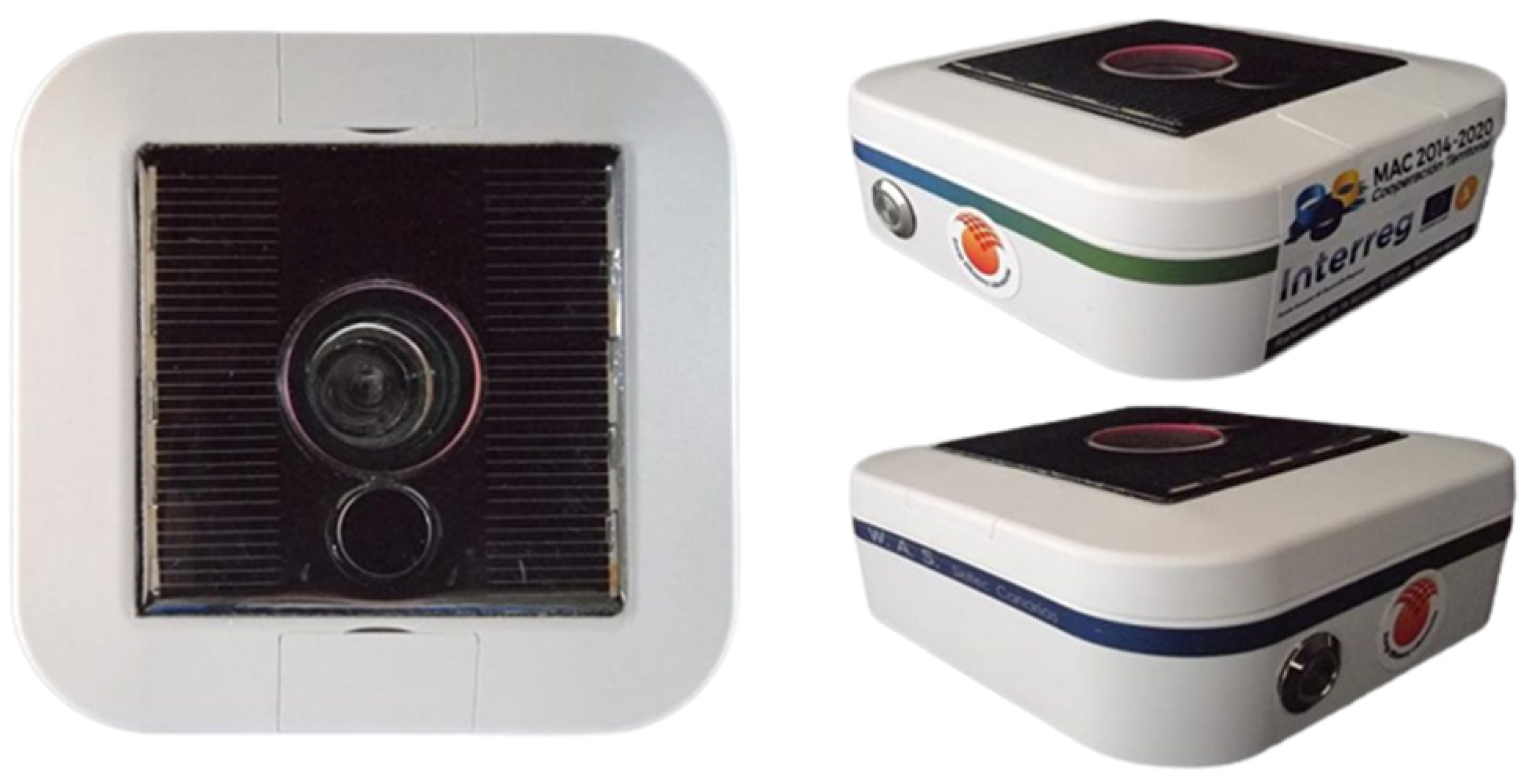
- Solar panel: BlueSolar 175 W–12 V Poly [49]
- Charge controller: BlueSolar PWM Light 12/24 V [50]
- Inverter: Phoenix 12 I 375 [51]
- Battery: Gel 12 V–90 A BAT 412800104 [52]
- Weather station: Davis Vantage Vue + Weatherlink Live [53]
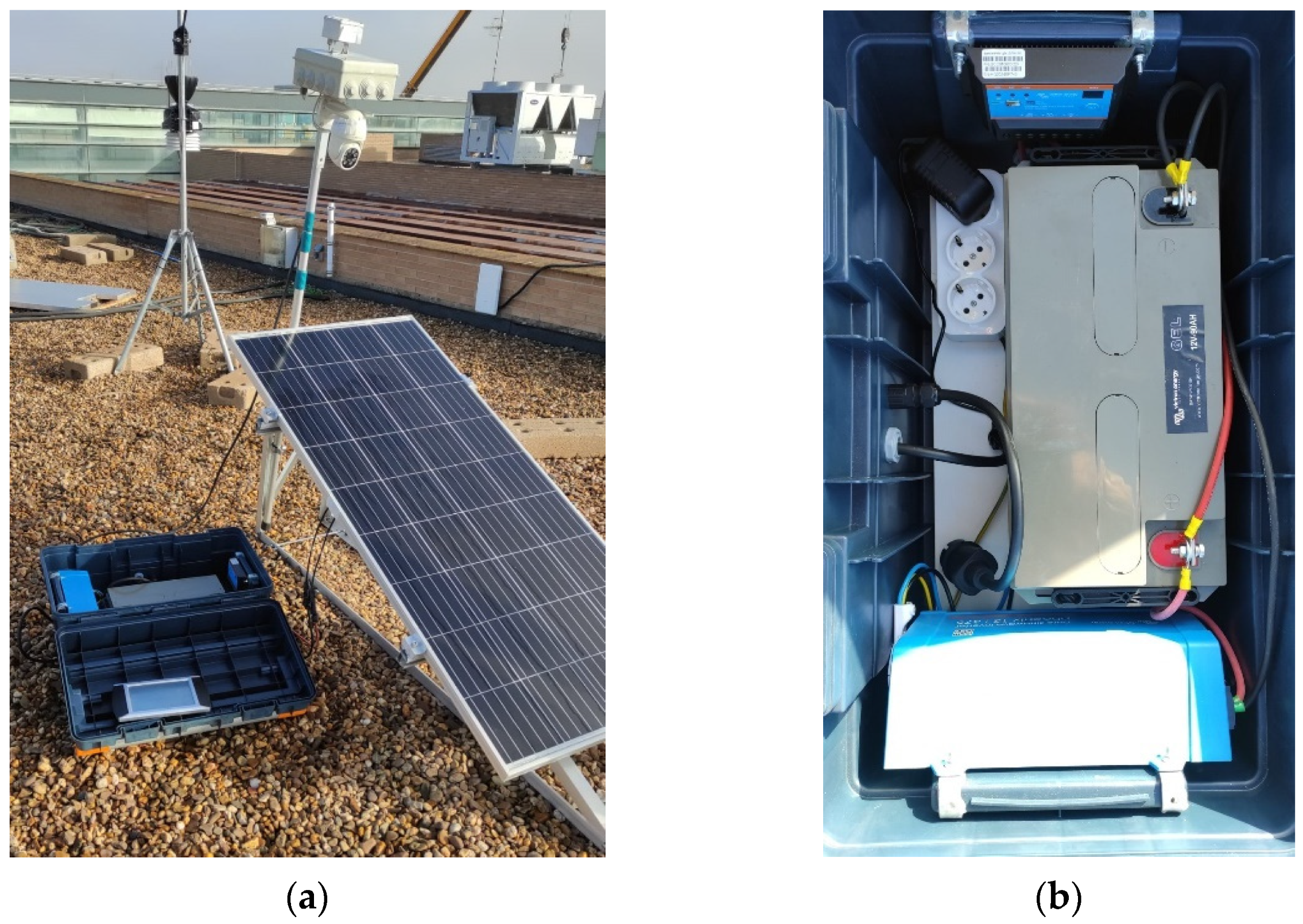


- Luminous flux: 4800 lm (30 W)/7200 lm (60 W)
- Protection rating: IP65
- Colour: Neutral white
- Voltage: 230 Volt
- EU energy label: A+
- Colour temperature: 5200 K
- Colour rendering index: 80.00

Appendix B



References
- Kyba, C.C.M.; Kuester, T.; Sánchez De Miguel, A.; Baugh, K.; Jechow, A.; Hölker, F.; Bennie, J.; Elvidge, C.D.; Gaston, K.J.; Guanter, L. Artificially Lit Surface of Earth at Night Increasing in Radiance and Extent. Sci. Adv. 2017, 3, e1701528. [Google Scholar] [CrossRef] [PubMed]
- Falchi, F.; Cinzano, P.; Duriscoe, D.; Kyba, C.C.M.; Elvidge, C.D.; Baugh, K.; Portnov, B.A.; Rybnikova, N.A.; Furgoni, R. The New World Atlas of Artificial Night Sky Brightness. Sci. Adv. 2016, 2, e1600377. [Google Scholar] [CrossRef] [PubMed]
- de Miguel, A.S.; Bennie, J.; Rosenfeld, E.; Dzurjak, S.; Gaston, K.J. First Estimation of Global Trends in Nocturnal Power Emissions Reveals Acceleration of Light Pollution. Remote Sens. 2021, 13, 3311. [Google Scholar] [CrossRef]
- Green, R.F.; Luginbuhl, C.B.; Wainscoat, R.J.; Duriscoe, D. The Growing Threat of Light Pollution to Ground-Based Observatories. Astron. Astrophys. Rev. 2022, 30, 1. [Google Scholar] [CrossRef]
- Tsao, J.Y.; Saunders, H.D.; Creighton, J.R.; Coltrin, M.E.; Simmons, J.A. Solid-State Lighting: An Energy-Economics Perspective. J. Phys. D Appl. Phys. 2010, 43, 354001. [Google Scholar] [CrossRef]
- Owens, A.C.S.; Lewis, S.M. The Impact of Artificial Light at Night on Nocturnal Insects: A Review and Synthesis. Ecol. Evol. 2018, 8, 11337–11358. [Google Scholar] [CrossRef]
- Owens, A.C.S.; Cochard, P.; Durrant, J.; Farnworth, B.; Perkin, E.K.; Seymoure, B. Light Pollution Is a Driver of Insect Declines. Biol. Conserv. 2020, 241, 108259. [Google Scholar] [CrossRef]
- Mcdonnell, M.J.; Hahs, A.H.; Breuste, J.H. Chapter 15. Light Pollution and the Impact of Artificial Night Lighting on Insects; Cambridge University Press: Cambridge, UK, 2009. [Google Scholar]
- Altermatt, F.; Ebert, D. Reduced Flight-to-Light Behaviour of Moth Populations Exposed to Long-Term Urban Light Pollution. Biol. Lett. 2016, 12, 20160111. [Google Scholar] [CrossRef]
- Knop, E.; Zoller, L.; Ryser, R.; Gerpe, C.; Hörler, M.; Fontaine, C. Artificial Light at Night as a New Threat to Pollination. Nature 2017, 548, 206–209. [Google Scholar] [CrossRef]
- Light Pollution Effects on Wildlife and Ecosystems. Available online: https://www.darksky.org/light-pollution/wildlife/ (accessed on 16 December 2022).
- Hölker, F.; Wolter, C.; Perkin, E.K.; Tockner, K. Light Pollution as a Biodiversity Threat. Trends Ecol. Evol. 2010, 25, 681–682. [Google Scholar] [CrossRef]
- Gaston, K.J.; Bennie, J.; Davies, T.W.; Hopkins, J. The Ecological Impacts of Nighttime Light Pollution: A Mechanistic Appraisal. Biol. Rev. 2013, 88, 912–927. [Google Scholar] [CrossRef]
- Gaston, K.J.; Visser, M.E.; Hölker, F. The Biological Impacts of Artificial Light at Night: The Research Challenge. Philos. Trans. R. Soc. B Biol. Sci. 2015, 370, 20140133. [Google Scholar] [CrossRef]
- Grubisic, M.; Haim, A.; Bhusal, P.; Dominoni, D.M.; Gabriel, K.M.A.; Jechow, A.; Kupprat, F.; Lerner, A.; Marchant, P.; Riley, W.; et al. Light Pollution, Circadian Photoreception, and Melatonin in Vertebrates. Sustainability 2019, 11, 6400. [Google Scholar] [CrossRef]
- Las Medidas Del Gobierno Para Reducir Hasta Un 13.5% El Consumo de Gas; Agencia EFE: 2022. Available online: https://efe.com/economia/2022-10-11/gobierno-aprueba-plan-contingencia-energetica/ (accessed on 16 December 2022).
- Ściężor, T. Effect of Street Lighting on the Urban and Rural Night-Time Radiance and the Brightness of the Night Sky. Remote Sens. 2021, 13, 1654. [Google Scholar] [CrossRef]
- Espey, B.R. Empirical Modelling of Public Lighting Emission Functions. Remote Sens. 2021, 13, 3827. [Google Scholar] [CrossRef]
- Kyba, C.C.M.; Ruby, A.; Kuechly, H.U.; Kinzey, B.; Miller, N.; Sanders, J.; Barentine, J.; Kleinodt, R.; Espey, B. Direct Measurement of the Contribution of Street Lighting to Satellite Observations of Nighttime Light Emissions from Urban Areas. Light. Res. Technol. 2021, 53, 189–211. [Google Scholar] [CrossRef]
- Zielińska-Dabkowska, K.M.; Xavia, K.; Bobkowska, K. Assessment of Citizens’ Actions against Light Pollution with Guidelines for Future Initiatives. Sustainability 2020, 12, 4997. [Google Scholar] [CrossRef]
- Pothukuchi, K. City Light or Star Bright: A Review of Urban Light Pollution, Impacts, and Planning Implications. J. Plan Lit. 2021, 36, 155–169. [Google Scholar] [CrossRef]
- Brons, J.A.; Bullough, J.D.; Rea, M.S. Outdoor Site-Lighting Performance: A Comprehensive and Quantitative Framework for Assessing Light Pollution. Light. Res. Technol. 2008, 40, 201–224. [Google Scholar] [CrossRef]
- Isobe, S.; Hamamura, S. Light Pollution and Its Energy Loss. Astrophys. Space Sci. 2000, 273, 289–294. [Google Scholar] [CrossRef]
- Gocova, A. The Night Issue. Alternat. J. 2013, 39, 5. [Google Scholar]
- Outdoor Lighting Basics. Available online: https://www.darksky.org/our-work/lighting/lighting-for-citizens/lighting-basics/ (accessed on 16 December 2022).
- Jägerbrand, A.K. New Framework of Sustainable Indicators for Outdoor LED (Light Emitting Diodes) Lighting and SSL (Solid State Lighting). Sustainability 2015, 7, 1028–1063. [Google Scholar] [CrossRef]
- Barentine, J.C.; Walker, C.E.; Kocifaj, M.; Kundracik, F.; Juan, A.; Kanemoto, J.; Monrad, C.K. Skyglow Changes over Tucson, Arizona, Resulting from a Municipal LED Street Lighting Conversion. J. Quant. Spectrosc. Radiat. Transf. 2018, 212, 10–23. [Google Scholar] [CrossRef]
- Das, N.; Pal, N.; Pradip, S.K. Economic Cost Analysis of LED over HPS Flood Lights for an Efficient Exterior Lighting Design Using Solar PV. Build Env. 2015, 89, 380–392. [Google Scholar] [CrossRef]
- Yoomak, S.; Jettanasen, C.; Ngaopitakkul, A.; Bunjongjit, S.; Leelajindakrairerk, M. Comparative Study of Lighting Quality and Power Quality for LED and HPS Luminaires in a Roadway Lighting System. Energy Build 2018, 159, 542–557. [Google Scholar] [CrossRef]
- Garstang, R.H. Night sky brightness at observatories and sites. Publ. Astron. Soc. Pac. 1989, 101, 306. [Google Scholar] [CrossRef]
- Riegel, K.W. Light Pollution. Science 1973, 179, 1285–1291. [Google Scholar] [CrossRef]
- Cayrel, R. 50. Identification and Protection of Existing and Potential Observatory Sites. Trans. Int. Astron. Union 1979, 17, 215–223. [Google Scholar] [CrossRef]
- Aubé, M.; Fortin, N.; Turcotte, S.; García, B.; Mancilla, A.; Maya, A.J. Evaluation of the Sky Brightness at Two Argentinian Astronomical Sites. Publ. Astron. Soc. Pac. 2014, 126, 1068–1077. [Google Scholar] [CrossRef]
- Sefako, R. Session 21.3-Radio and Optical Site Protection. In Proceedings of the International Astronomical Union; Cambridge University Press: Cambridge, UK, 2015; Volume 11, pp. 453–462. [Google Scholar]
- Green, R.F. Light Pollution and Protecting Astronomical Sites in China. In Proceedings of the International Astronomical Union; Cambridge University Press: Cambridge, MA, USA, 2012; Volume 10, p. 757. [Google Scholar]
- Karttunen, H.; Kröger, P.; Oja, H.; Poutanen, M.; Donner, K.J. Fundamental Astronomy, 5th ed.; Ursa: Helsinki, Finland, 2007; ISBN 978-3-540-34144-4. [Google Scholar]
- Interreg GLOBALTUR EUROACE. Available online: https://globaltur.eu/ (accessed on 16 December 2022).
- Diputación Provincial de Cáceres Astronomía En Tajo Internacional—Guía Práctica Para Ver Las Estrellas. Available online: https://turismotajointernacional.es/wp-content/uploads/2021/05/Astronomia-en-Tajo-Internacional-Guia-practica-para-ver-las-estrellas.pdf (accessed on 27 January 2023).
- Kobav, M.B.; Eržen, M.; Bizjak, G. Sustainable Exterior Lighting for Cultural Heritage Buildings and Monuments. Sustainability 2021, 13, 10159. [Google Scholar] [CrossRef]
- IBM SPSS. Available online: https://www.ibm.com/es-es/spss (accessed on 16 December 2022).
- Papalambrou, A.; Doulos, L.T. Identifying, Examining, and Planning Areas Protected from Light Pollution. The Case Study of Planning the First National Dark Sky Park in Greece. Sustainability 2019, 11, 5963. [Google Scholar] [CrossRef]
- Zielinska-Dabkowska, K.M.; Xavia, K. Looking up to the Stars. A Call for Action to Save New Zealand’s Dark Skies for Future Generations to Come. Sustainability 2021, 13, 13472. [Google Scholar] [CrossRef]
- Bista, D.; Bista, A.; Shrestha, A.; Doulos, L.T.; Bhusal, P.; Zissis, G.; Topalis, F.; Chhetri, B.B. Lighting for Cultural and Heritage Site: An Innovative Approach for Lighting in the Distinct Pagoda-Style Architecture of Nepal. Sustainability 2021, 13, 2720. [Google Scholar] [CrossRef]
- Fotios, S.; Gibbons, R. Road Lighting Research for Drivers and Pedestrians: The Basis of Luminance and Illuminance Recommendations. Light. Res. Technol. 2018, 50, 154–186. [Google Scholar] [CrossRef]
- Tabaka, P.; Rozga, P. Influence of a Light Source Installed in a Luminaire of Opal Sphere Type on the Effect of Light Pollution. Energies 2020, 13, 306. [Google Scholar] [CrossRef]
- Carli, R.; Dotoli, M.; Pellegrino, R. A Decision-Making Tool for Energy Efficiency Optimization of Street Lighting. Comput. Oper. Res. 2018, 96, 223–235. [Google Scholar] [CrossRef]
- Alarcon, M.R.; Puig-Subirà, M.; Serra-Ricart, M.; Lemes-Perera, S.; Mallorquín, M.; López, C. SG-WAS: A New Wireless Autonomous Night Sky Brightness Sensor. Sensors 2021, 21, 5590. [Google Scholar] [CrossRef]
- Solar Panel BlueSolar 175W—12V Poly. Available online: https://www.victronenergy.com.es/solar-pv-panels/bluesolar-panels (accessed on 26 January 2023).
- Charge Controller BlueSolar PWM Light 12/24V. Available online: https://www.victronenergy.com.es/solar-charge-controllers/bluesolar-pwm (accessed on 26 January 2023).
- Inversor Phoenix 12 I 375. Available online: https://www.victronenergy.com.es/upload/documents/Datasheet-Phoenix-Inverter-VE.Direct-250VA-1200VA-ES.pdf (accessed on 26 January 2023).
- Gel Battery 12V-90A BAT 412800104. Available online: https://www.victronenergy.com.es/batteries/gel-and-agm-batteries (accessed on 26 January 2023).
- Davis Vantage Vue + Weatherlink Live. Available online: https://www.estacionesdavis.es/es/davis-vantage-vue/84-pack-davis-vantage-vue-weatherlink-live.html (accessed on 26 January 2023).
- Sieltec Canarias SKYGLOW V3.1. Available online: https://www.sieltec.es/2022/07/20/proyecto-de-desarrollo-experimental-skyglow/ (accessed on 27 January 2023).
- Oculus All Sky Camera—Starlight Xpress. Available online: https://www.sxccd.com/product/oculus-all-sky-camera-180/ (accessed on 27 January 2023).
- LEDKIA LIGHTING LED IP65 HE Slim PRO 4800K—5200K. Available online: https://www.amazon.es/LEDKIA-LIGHTING-Proyector-Exterior-Regulable/dp/B09FZJJJ18/ (accessed on 27 January 2023).
- Panel reflector Walimex 50 × 200 cm. Available online: https://www.amazon.es/Walimex-rollbares-Reflektor-panel-150x200cm/dp/B0074ECRSS/ (accessed on 27 January 2023).
- NASA “Blue Marble” Navigator. Available online: https://blue-marble.de/nightlights/2022 (accessed on 16 December 2022).
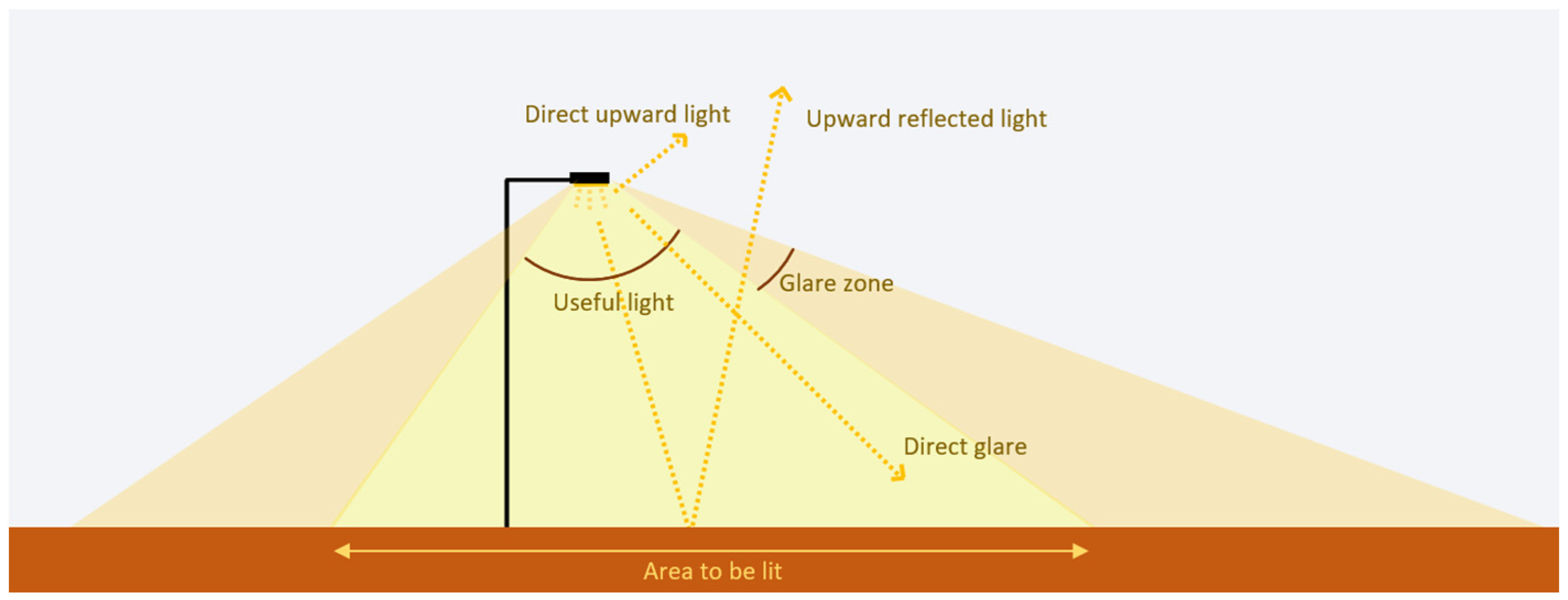



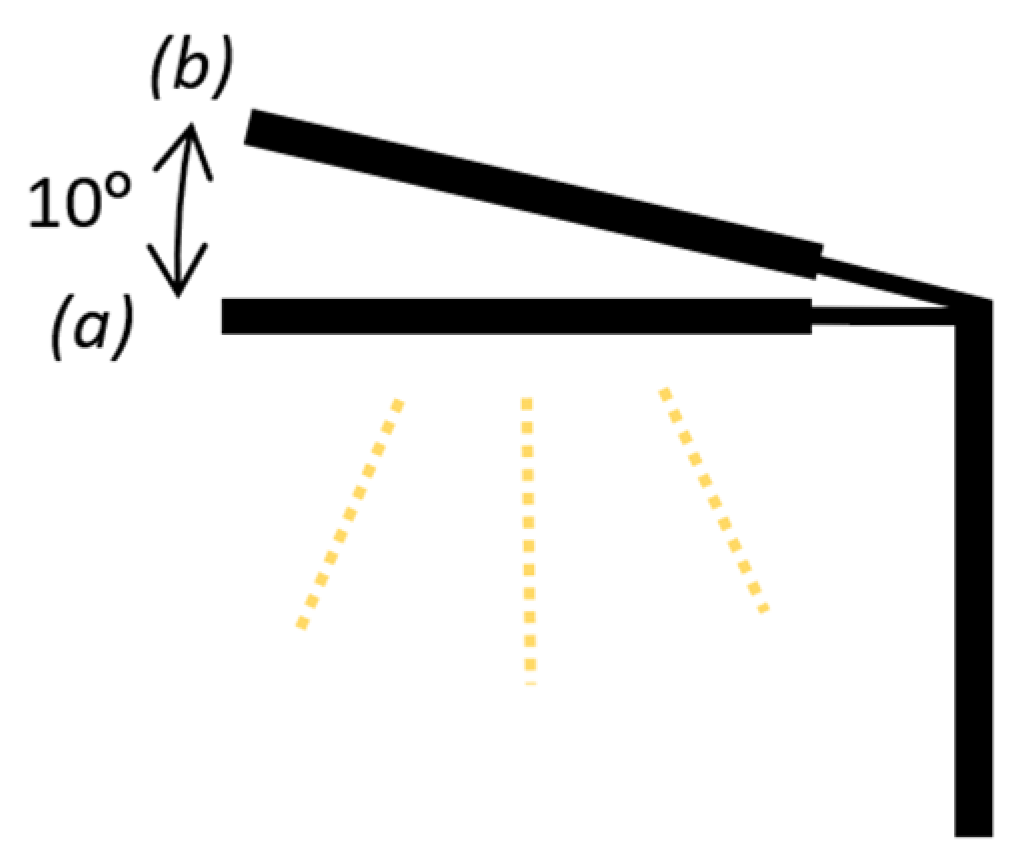


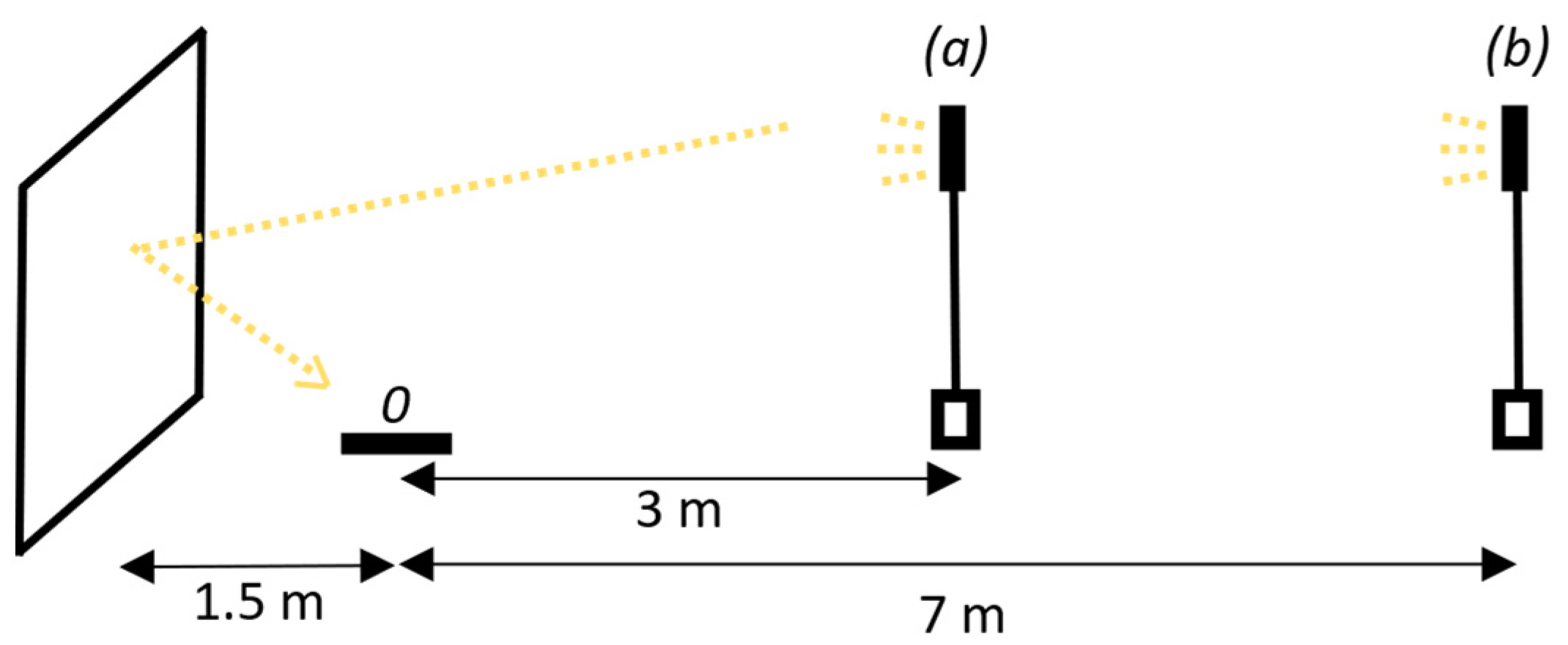

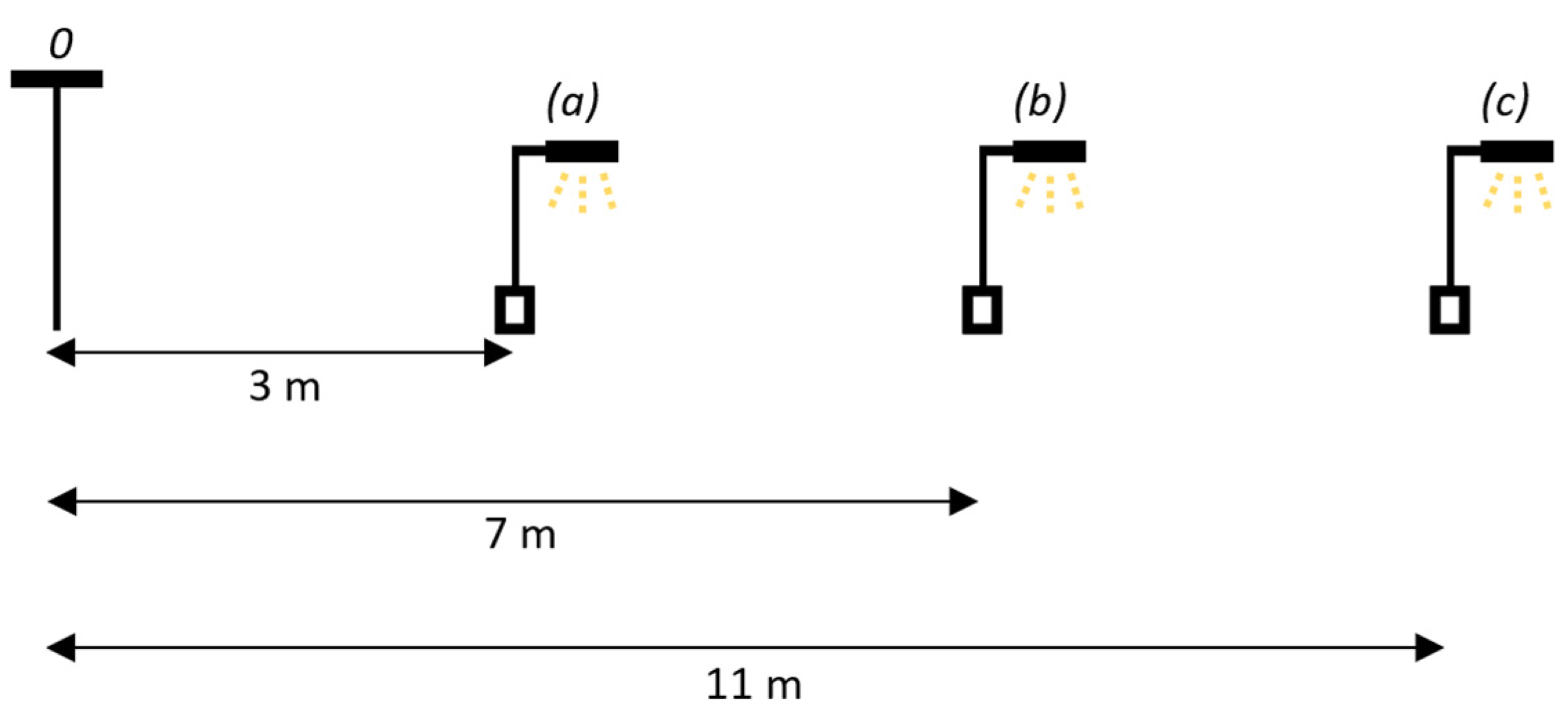




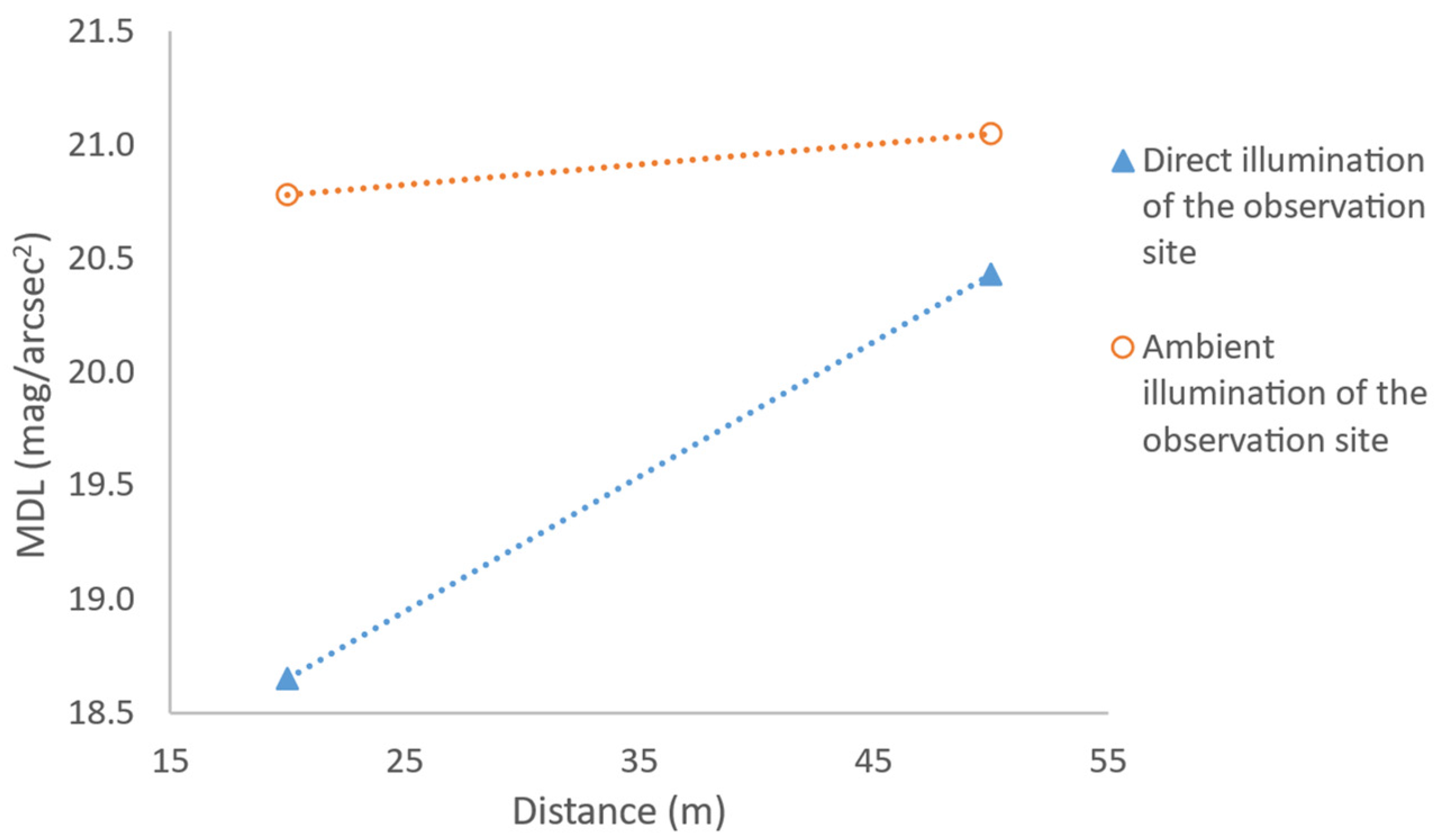

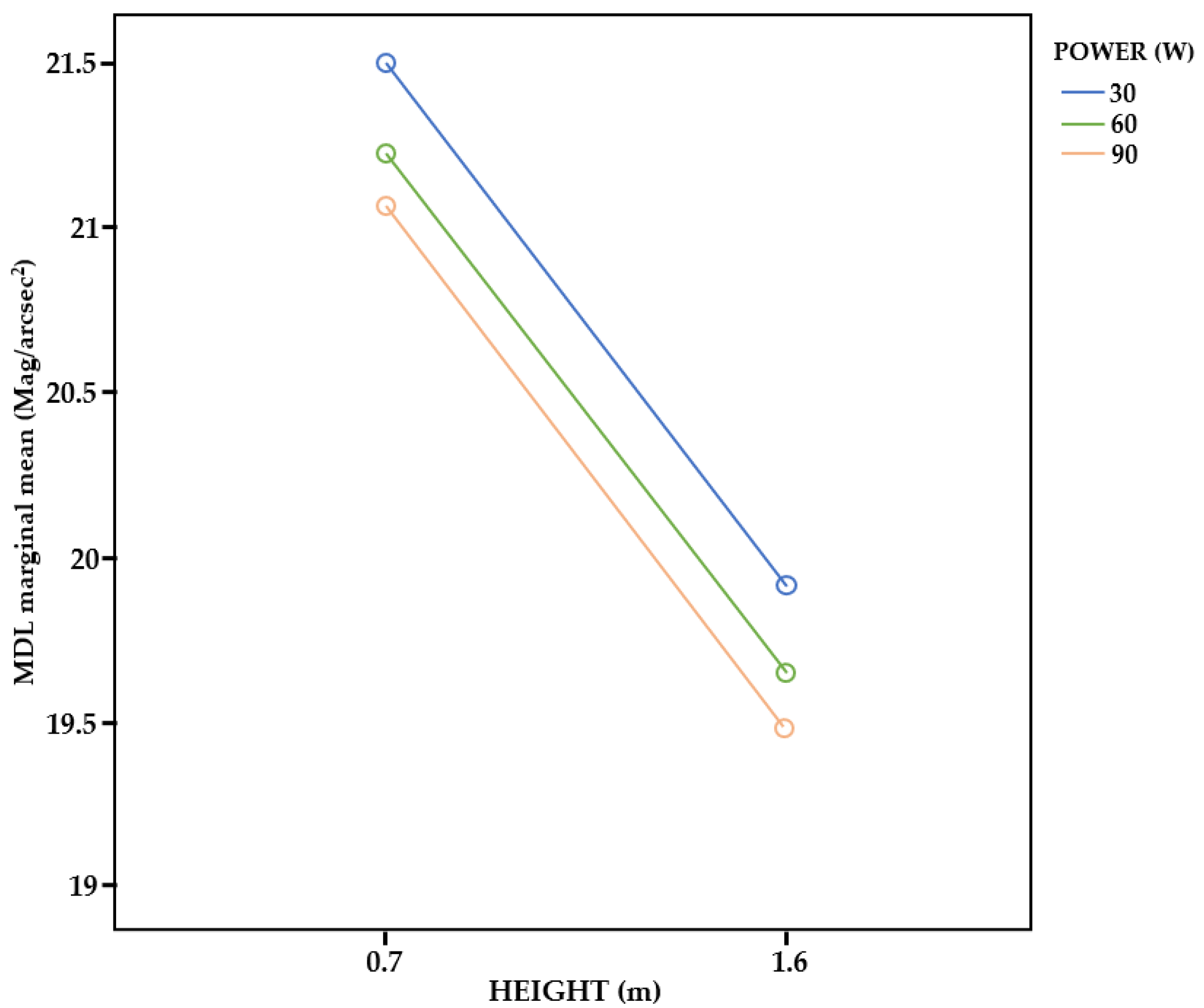

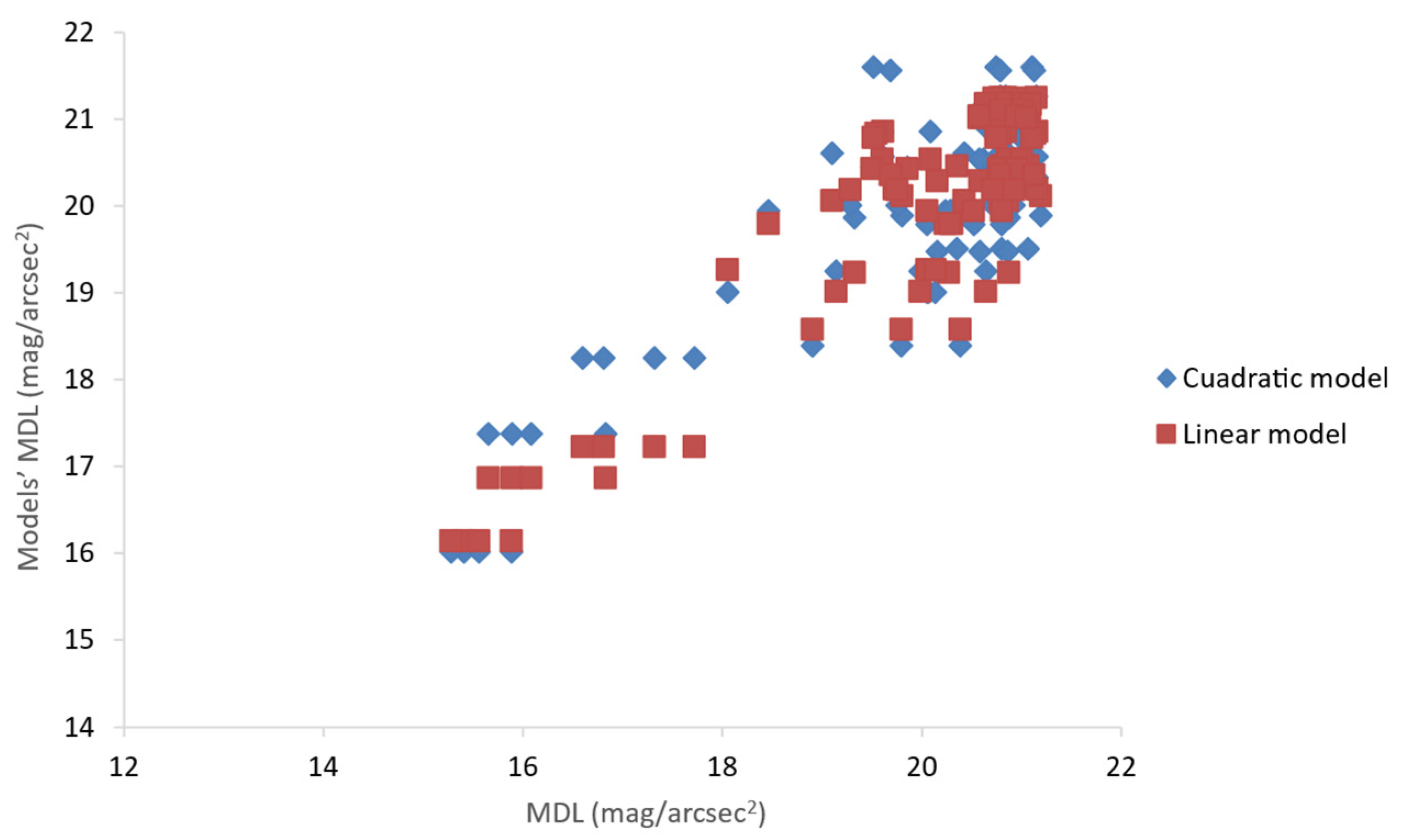
| Distance | Experimental Value (mag/arcsec2) | Reference Value (mag/arcsec2) |
|---|---|---|
| 20 m | 18.65 | 21.06 |
| 50 m | 20.43 | 21.04 |
| Distance | Experimental Value (mag/arcsec2) | Reference Value (mag/arcsec2) |
|---|---|---|
| 20 m | 20.78 | 21.00 |
| 50 m | 21.05 | 21.07 |
| Origin | Type III of Sum of Squares | Degrees of Freedom | Root Mean Square | F | Sig. |
|---|---|---|---|---|---|
| Corrected model | 121.047 a | 6 | 20.175 | 16.932 | 0.000 |
| Interception | 27,925.917 | 1 | 27,925.917 | 23,438.100 | 0.000 |
| Power | 3.069 | 2 | 1.534 | 1.288 | 0.281 |
| Distance | 65.014 | 2 | 32.507 | 27.283 | 0.000 |
| Height | 50.110 | 1 | 50.110 | 42.057 | 0.000 |
| Inclination | 28.905 | 1 | 28.905 | 24.260 | 0.000 |
| Error | 106.041 | 89 | 1.191 | ||
| Total | 38,279.479 | 96 | |||
| Total corrected | 227.088 | 95 |
| MDL | Power | Distance | Height | Inclination | |
|---|---|---|---|---|---|
| MDL | 1 | −0.115 | 0.418 ** | −0.353 ** | 0.329 ** |
| Power | −0.115 | 1 | 0 | 0 | 0 |
| DistancE | 0.418 ** | 0 | 1 | 0.236 | −0.044 |
| Height | −0.353 ** | 0 | 0.236 | 1 | 0 |
| Inclination | 0.329 ** | 0 | −0.044 | 0 | 1 |
| Parameter | Estimate | Standard Error | Lower Bound a | Upper Bound a |
|---|---|---|---|---|
| a0 | 23.860 | 0.960 | 21.952 | 25.769 |
| a1 | −5.257 × 10−5 | 0.000 | 0.000 | 0.000 |
| a2 | −0.284 | 0.134 | −0.551 | −0.017 |
| a3 | −4.493 | 0.662 | −5.810 | −3.176 |
| a4 | 0.013 | 0.064 | −0.114 | 0.140 |
| a5 | 1.506 × 10−5 | 0.000 | −2.635 × 10−6 | 3.275 × 10−5 |
| a6 | −9.024 × 10−5 | 0.000 | 0.000 | 2.617 × 10−5 |
| a7 | 4.281 × 10−6 | 0.000 | −5.586 × 10−6 | 1.415 × 10−5 |
| a8 | 0.446 | 0.075 | 0.297 | 0.595 |
| a9 | −0.038 | 0.005 | −0.049 | −0.027 |
| a10 | 0.227 | 0.035 | 0.157 | 0.297 |
| Parameter | Estimate | Standard Error | Lower Bound a | Upper Bound a |
|---|---|---|---|---|
| a0 | 19.367 | 0.000 | 19.367 | 19.367 |
| a1 | 5.286 × 10−5 | 0.035 | −0.070 | 0.070 |
| a2 | 0.102 | 0.006 | 0.089 | 0.114 |
| a3 | 1.000 | 0.015 | 0.970 | 1.030 |
| a4 | 1.000 | 0.000 | 1.000 | 1.000 |
| a5 | 2.606 × 10−5 | 0.203 | −0.403 | 0.403 |
| a6 | 0.000 | 0.000 | 0.000 | 0.000 |
| a7 | 8.777 × 10−6 | 1.369 | −2.723 | 2.723 |
| a8 | 0.154 | 0.087 | −0.019 | 0.326 |
| a9 | −0.034 | 0.000 | −0.034 | −0.034 |
| a10 | 0.186 | 0.000 | 0.186 | 0.186 |
| a11 | 1.066 × 10−8 | 0.000 | −0.001 | 0.001 |
| a12 | −0.007 | 0.000 | −0.007 | −0.007 |
Disclaimer/Publisher’s Note: The statements, opinions and data contained in all publications are solely those of the individual author(s) and contributor(s) and not of MDPI and/or the editor(s). MDPI and/or the editor(s) disclaim responsibility for any injury to people or property resulting from any ideas, methods, instructions or products referred to in the content. |
© 2023 by the authors. Licensee MDPI, Basel, Switzerland. This article is an open access article distributed under the terms and conditions of the Creative Commons Attribution (CC BY) license (https://creativecommons.org/licenses/by/4.0/).
Share and Cite
Martínez-Martín, A.; Bocho-Roas, A.; Carmona-Fernández, D.; Calderón-Godoy, M.; Jaramillo-Morán, M.Á.; González, J.F. Influence of Illumination Parameters on Night Sky Observation in Rural Areas. Sustainability 2023, 15, 9359. https://doi.org/10.3390/su15129359
Martínez-Martín A, Bocho-Roas A, Carmona-Fernández D, Calderón-Godoy M, Jaramillo-Morán MÁ, González JF. Influence of Illumination Parameters on Night Sky Observation in Rural Areas. Sustainability. 2023; 15(12):9359. https://doi.org/10.3390/su15129359
Chicago/Turabian StyleMartínez-Martín, Alejandro, Adrián Bocho-Roas, Diego Carmona-Fernández, Manuel Calderón-Godoy, Miguel Ángel Jaramillo-Morán, and Juan Félix González. 2023. "Influence of Illumination Parameters on Night Sky Observation in Rural Areas" Sustainability 15, no. 12: 9359. https://doi.org/10.3390/su15129359
APA StyleMartínez-Martín, A., Bocho-Roas, A., Carmona-Fernández, D., Calderón-Godoy, M., Jaramillo-Morán, M. Á., & González, J. F. (2023). Influence of Illumination Parameters on Night Sky Observation in Rural Areas. Sustainability, 15(12), 9359. https://doi.org/10.3390/su15129359








